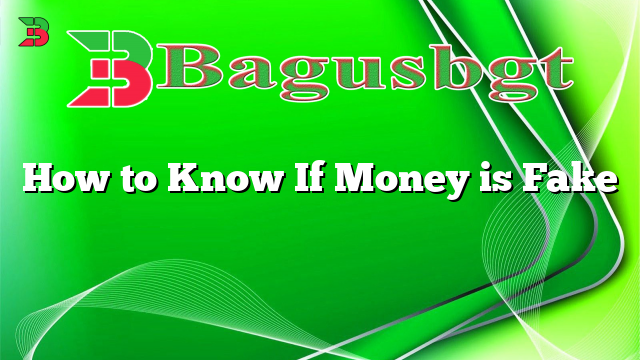Hello readers, welcome to this informative article on how to identify counterfeit money. In today’s world, it is crucial to be aware of the methods used by counterfeiters to create fake currency. By understanding the key signs and security features, you can protect yourself and ensure the legitimacy of your money. In this article, we will discuss ten essential tips to help you determine whether a banknote is genuine or counterfeit.
1. Watermark
A legitimate banknote should have a watermark, a faint image that becomes visible when held up to the light. The watermark is typically a portrait of a famous figure featured on the banknote, such as a president or a national hero. Counterfeit banknotes often lack this watermark or have a blurry version, making it an important feature to check.
2. Security Thread
Another crucial security feature is the presence of a security thread embedded in the banknote. This thin strip is visible when held up to the light and contains microprinting or a repeated pattern. Counterfeit banknotes may have a visible thread, but it is often a simple printed line or completely absent.
3. Raised Printing
Legitimate banknotes have raised printing, which can be felt by running your fingers over the surface. This printing technique gives the banknote a unique texture that cannot be replicated easily. Counterfeit money may lack this raised texture, feeling unnaturally smooth to the touch.
4. Microprinting
Microprinting refers to tiny text or numbers that are visible under magnification. Authentic banknotes incorporate microprinting in various areas, such as the borders or within the design. Counterfeiters often struggle to reproduce this level of detail accurately, resulting in blurry or distorted microprinting.
5. Color-Shifting Ink
Certain banknotes use color-shifting ink, which means that the color of the ink changes when viewed from different angles. This feature is difficult to replicate and is commonly found in higher denominations. Counterfeit banknotes may lack this color-shifting effect or have an inconsistent appearance.
6. Ultraviolet (UV) Light
Using an ultraviolet (UV) light can reveal additional security features on banknotes. Legitimate currency often includes fluorescent ink that becomes visible under UV light. Counterfeit money may not have this fluorescent reaction, indicating its inauthenticity.
7. Serial Numbers
Each banknote has a unique serial number, which is printed in a consistent font and style. Counterfeit banknotes may have irregular or mismatched serial numbers, providing a clear indication that the money is fake.
8. Quality of Printing
The printing quality of genuine banknotes is typically high, with sharp lines, clear details, and vibrant colors. Counterfeit money often exhibits blurred images, smudged ink, or uneven borders. Examining the overall printing quality can help identify counterfeit banknotes.
9. Holograms and Foil
Many banknotes incorporate holograms or foil elements as an added security measure. These features can be challenging to replicate and often display movement or change when tilted. Counterfeit banknotes may lack these holograms or have poorly reproduced versions.
10. Compare with Known Genuine Banknotes
A useful method to identify counterfeit money is to compare suspect banknotes with known genuine banknotes of the same denomination. By examining the differences and similarities, you can spot any discrepancies that indicate counterfeit currency.
Alternative Methods to Identify Counterfeit Money
In addition to the ten tips mentioned above, there are alternative methods that can help detect fake money. These include using counterfeit detection pens, checking for embedded security threads using a magnifying glass, or seeking assistance from a professional in the banking industry.
Table: Key Features to Identify Counterfeit Money
Feature |
Authentic Banknote |
Counterfeit Banknote |
|---|---|---|
Watermark |
Clearly visible |
Blurry or absent |
Security Thread |
Visible and contains microprinting or pattern |
Simple line or absent |
Raised Printing |
Can be felt by touch |
Smooth texture |
Microprinting |
Clear and accurate |
Blurry or distorted |
Color-Shifting Ink |
Color changes at different angles |
Inconsistent appearance |
UV Light Reaction |
Fluorescent ink becomes visible |
No fluorescent reaction |
Serial Numbers |
Consistent font and style |
Irregular or mismatched |
Printing Quality |
Sharp lines, clear details, vibrant colors |
Blurry images, smudged ink, uneven borders |
Holograms and Foil |
Clearly visible with movement or change |
Absent or poorly reproduced |
Comparison |
Similar to known genuine banknotes |
Discrepancies with genuine banknotes |
Frequently Asked Questions (FAQ)
Q: Can counterfeit detection pens always identify fake money?
A: No, counterfeit detection pens are not foolproof. They work by detecting starch in the paper, which is present in most genuine banknotes but absent in counterfeit money made from different materials.
Q: Are all security features the same for every currency?
A: No, security features can vary between different currencies. It is essential to familiarize yourself with the specific security features of the currency you are handling to ensure its authenticity.
Q: What should I do if I suspect I have counterfeit money?
A: If you have doubts about the authenticity of a banknote, it is advised to contact your local authorities or bring it to a bank for examination.
Conclusion
Ensuring the legitimacy of money is crucial to protect yourself from financial losses. By familiarizing yourself with the security features outlined in this article and using the provided tips, you can confidently identify counterfeit money. Remember, staying informed and vigilant is the key to detect fake currency and maintain the integrity of financial transactions.
 Bagus Banget Kumpulan Informasi terbaru dari berbagai sumber yang terpercaya
Bagus Banget Kumpulan Informasi terbaru dari berbagai sumber yang terpercaya





